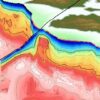Even though Earth’s magnetic field shields us from solar wind and space weather, it doesn’t always offer complete protection. Researchers have discovered a new mechanism in Earth’s space environment that can allow solar particles to slip through the planet’s first line of defense.
The constant interaction between Earth’s magnetic field and the sun’s supersonic particles sometimes results in small-scale plasma jets that can weaken the barrier’s protection against space weather effects, which not only produce glorious aurorae, but can also cause disruption of power grids and satellite communications.
Publishing in Nature Communications, researchers from KTH Royal Institute of Technology in Stockholm identified and explained the mechanism by which these high pressure jets occur when the speed of supersonic solar wind is blunted by the bow shock of Earth’s magnetosphere.
Lead author Savvas Raptis, a doctoral student at KTH, says that the results can apply universally. “The findings could be fundamental in shocks,” Raptis says. “They may also exist in other similar plasma environments, which can be found everywhere in universe, from astrophysical objects to other planets, as well as here at Earth.”
As plasma travels at supersonic speed toward Earth, it crashes into the magnetic field—which emanates from the planet’s core—and slows down abruptly, forming a bow shock. Beyond this point lies a transition zone known as the magnetosheath. That’s where compressed and heated plasma remains relatively uniform for the most part, but where downstream and upstream waves and particles interact and evolve—sometimes giving way to new phenomena. One consequence of this dynamic is the formation of jets with dynamic pressure greater than that of the solar wind itself.
Using the instruments aboard NASA’s four Magnetospheric Multiscale Mission (MMS) satellites, the researchers followed the formation of these downstream jets from the bow shock, and traced their origin as a direct consequence of the upstream wave evolution and the bow shock reformation, Raptis says.
Raptis says focusing on small-scale research is necessary to understand the details on how the space environment of Earth is configured. “Most research in recent decades has focused on the large-scale changes caused by macroscale phenomena connected to solar activity,” he says. “But as we discover more and more smaller-scale phenomena, we see that environments such as the Earth’s bow shock and associated phenomena like magnetosheath jets play a very important role.”
He says the research also underlines the importance of missions like MMS, which in 2015 launched four spacecraft into Earth’s orbit to travel in tetrahedral formation around the planet and enable high-resolution observations of the magnetosphere at work. KTH researchers such as Raptis’s co-authors Tomas Karlsson, professor of plasma physics, and researcher Per-Arne Lindqvist contributed to the MMS mission with the design of components, and they continue to perform research on the data the mission produces.
“We were able to observe previously unexplored parts of the Earth’s surrounding space environment,” Raptis says. “We showed how useful such space missions are for understanding and explaining nature. The evolution of shocks and how it is connected to the generation of jets is a necessary piece to understand the Earth’s space environment.”
More information:
Savvas Rapitis et al, Downstream high-speed plasma jet generation as a direct consequence of shock reformation, Nature Communications (2022). DOI: 10.1038/s41467-022-28110-4
Provided by
KTH Royal Institute of Technology
Citation:
Satellite data shows ‘shocking’ way Earth’s magnetic field produces plasma jets (2022, February 1)



